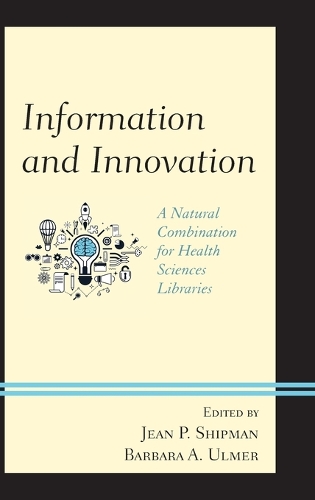
Information and Innovation: A Natural Combination for Health Sciences Libraries
(Hardback)
Publishing Details
Information and Innovation: A Natural Combination for Health Sciences Libraries
By (Author) Jean P. Shipman
Edited by Barbara A. Ulmer
Bloomsbury Publishing PLC
Rowman & Littlefield Publishers
1st August 2017
United States
Classifications
Professional and Scholarly
Non Fiction
Library and information services
020
Physical Properties
Hardback
218
Width 156mm, Height 239mm, Spine 21mm
467g
Description
As academic health sciences centers look toward innovative product development as their new income source with the decline of clinical income and research dollars, health sciences librarians and libraries can partner with these revenue-generating innovators to offer invaluable services, evidence, training, dissemination venues and attractive collaborative physical spaces equipped with the latest tools, such as 3-D printers, body scanners, models and video-monitors. This book uses case examples, including perspectives from both librarians and innovators, to illustrate how various health sciences libraries have partnered with innovators by offering valuable services and creative products and spaces especially innovators who create medical digital therapeutics devices and apps. Many health sciences libraries are transforming their physical spaces into collaboration or maker spaces to spark innovation and discoveries. Key health sciences libraries that have done so to enable others to learn more about what professional benefits result from such collisions of information and innovation are highlighted here. Also included in the book are chapters that describe various innovation competitions and products that help to showcase the unique scholarly output that is generated by innovators. Transferring the knowledge of librarians who have progressed down this path to others is the key goal of this book.
Reviews
In today's complex health-care information environment, health-science librarians' roles are constantly evolving to connect with users in meaningful and creative ways. The library as placea destination for learning, research, and discoverycan be enhanced through innovation. Each of these place-based key themes of the book explore the concept of innovation in health science libraries. In 16 chapters the contributors address everything from the history of innovation in libraries and innovative technologies to innovative library spaces and facilities. They provide practical case examples from health-science libraries where such mechanisms have been implemented. Readers will find chapters on topics including makerspaces, gaming, apps, and collaborative library work spaces. As budget factors are a major barrier to innovative project implementation in any library setting, this work offers helpful examples of partnerships that can alleviate financial burdens and generate revenue. Edited by Shipman, former president of the Medical Library Association, and Ulmer, chapters are written by professionals in libraries, medicine, education, engineering, and technology. Content is applicable to librarians, educators, instructional designers, and information technology professionals in academic health science and hospital settings. Summing Up: Recommended. Graduate students through professionals/practitioners. * CHOICE *
This book is recommended for academic health sciences libraries and academic teaching hospital libraries with funding and staff to support innovation. University libraries supporting health sciences, technology, and information sciences programs may also find it valuable. * Journal of the Medical Library Association *
Those responsible for health sciences libraries should find inspiration -- and practical advice -- in Information and Innovation: A Natural Combination for Health Sciences Libraries. Expanding the ways in which librarians and libraries create, promote, and support health science innovation will increase the value of existing investments in organizing and providing access to data, information, and knowledge to fuel discovery. -- Betsy L. Humphreys, Medical Library Association 2007 Marcia C. Noyes Awardee
Information and Innovation: A Natural Combination for Health Sciences Libraries is an examination of the evolution of libraries, especially those in the health sciences, as natural incubators of innovation and discovery. The chapters outlining new librarian roles to promote innovation and entrepreneurism, and the practical examples of spatial transformations through detailed case studies, make this an extremely useful tool for universities as physical library spaces are transitioned. This is the first of its kind to walk academics through the process of providing the necessary tools for students and faculty from multiple disciplines to generate novel ideas and innovations. -- Barbara A. Epstein, Medical Library Association President, 2017-18 and Director, Health Sciences Library System, University of Pittsburgh
Innovators and entrepreneurs may not think to go ask a librarian, but they should! Finding the right resources and expertise at the critical time accelerates innovation. Information and Innovation: A Natural Combination for Health Sciences Libraries offers many excellent scenarios of productive partnerships taken from experiences at the Spencer S. Eccles Health Sciences Library, University of Utah, as well as other universities. This book illustrates how quality evidence supports efficient and effective ideation and product development and is a must read for anyone with a clever idea who wants to make a difference in this world. -- Glenn D. Prestwich, Chair, International Commercialization Coordination Council, Presidential Special Assistant for Faculty Entrepreneurship, and Founding Director, Entrepreneurial Faculty Scholars, The University of Utah
Author Bio
Jean P. Shipman is Executive Director, Knowledge Management and Spencer S. Eccles Health Sciences Library; Director of the MidContinental Region and National Training Office of the National Network of Libraries of Medicine; and Director for Information Transfer, Center for Medical Innovation. She is also Adjunct Professor, Department of Biomedical Informatics, School of Medicine, all at the University of Utah. Barbara A. Ulmer has experience as the Managing Editor of a small publishing company and a background in financial and technologically innovative process analysis. She co-founded and served as Chief Financial Officer of a technology start-up company in the early days of e-book adoption and was deeply involved with advancing social innovations.
